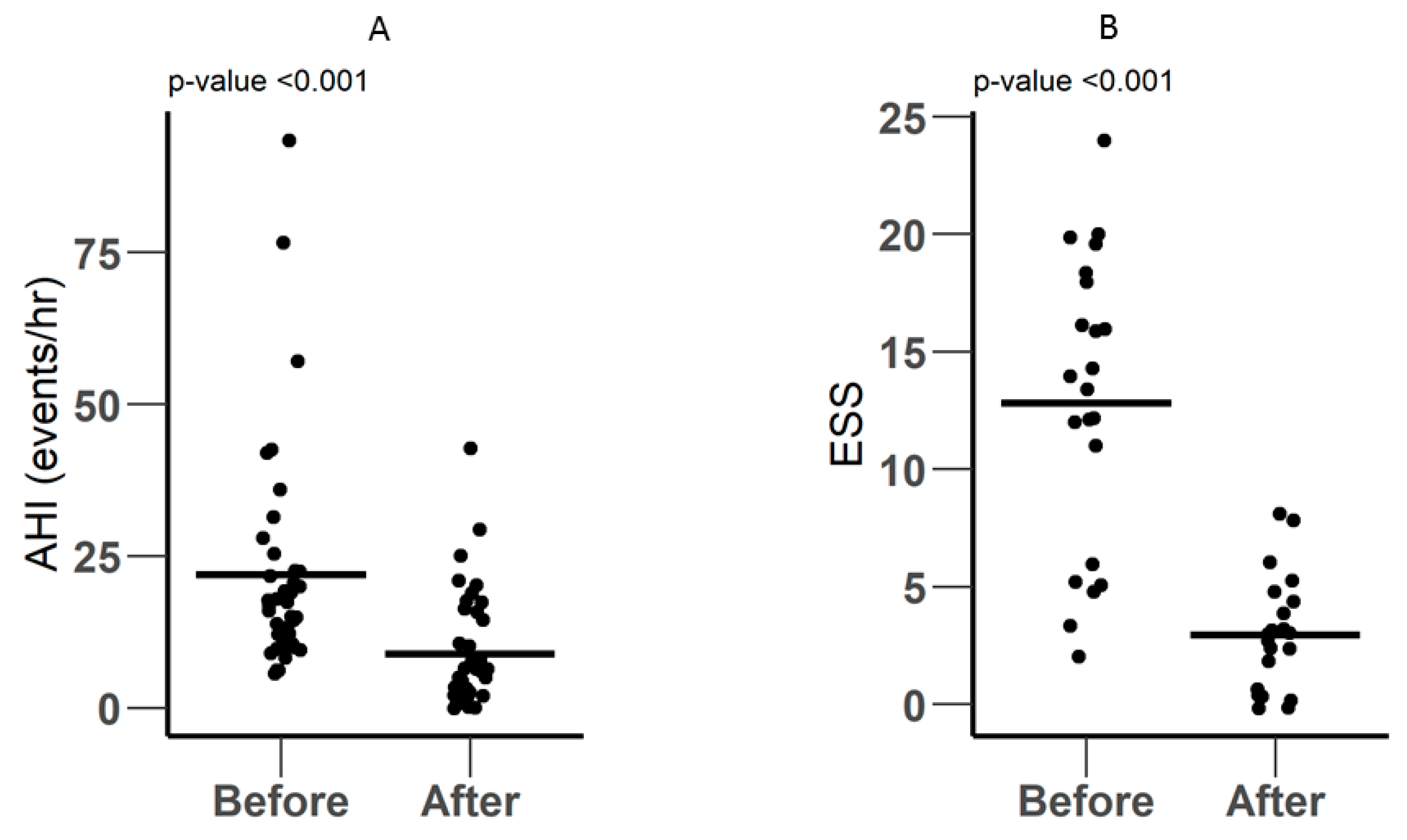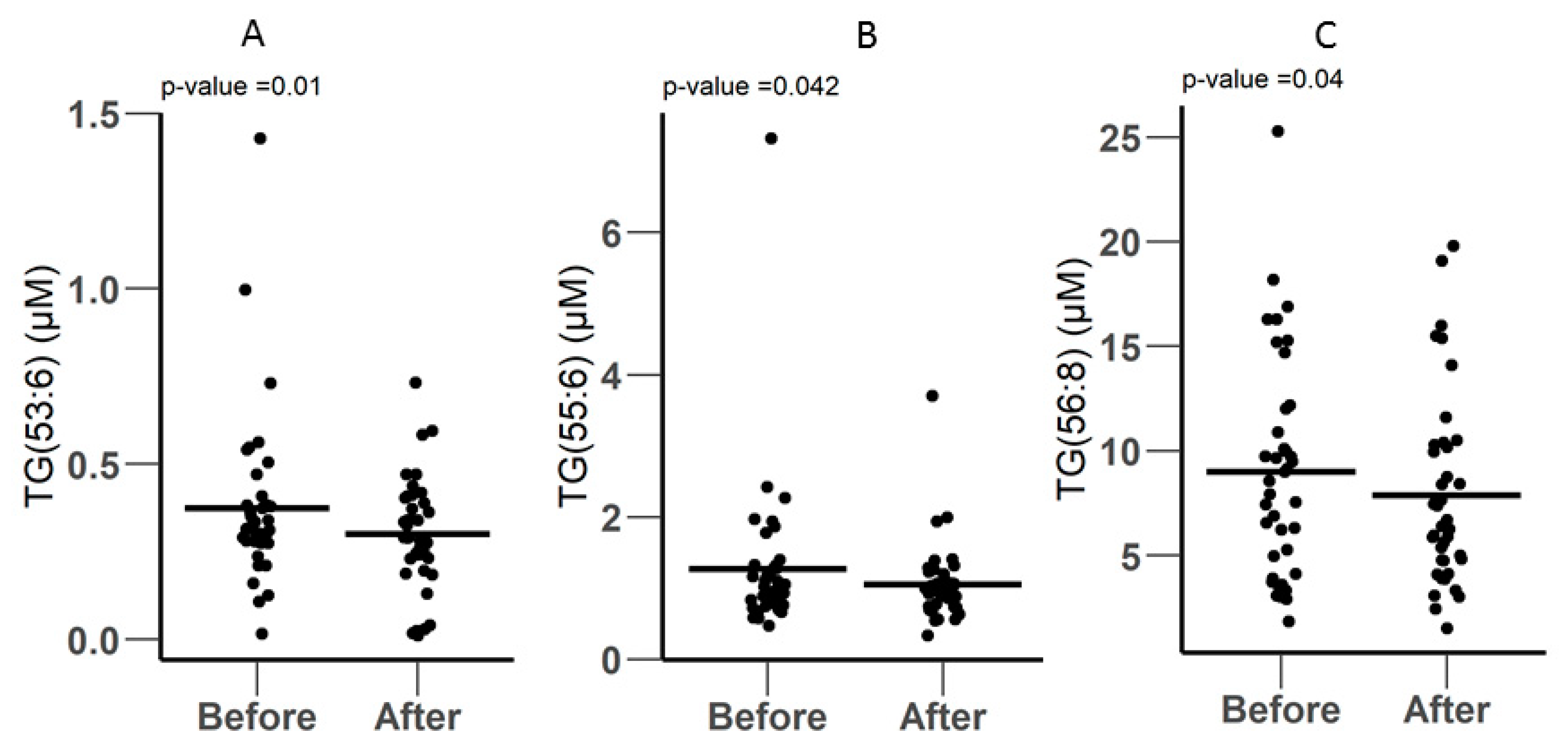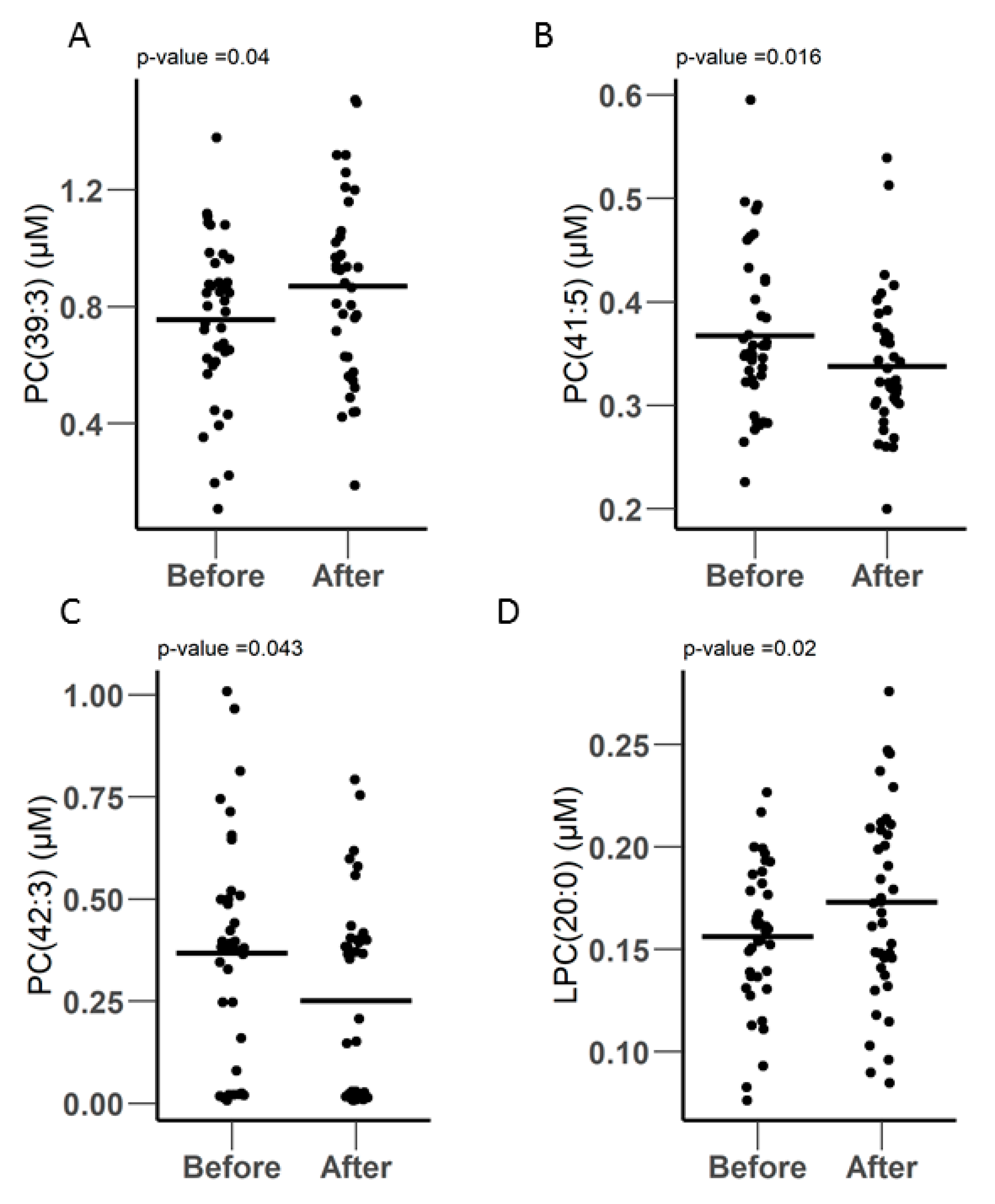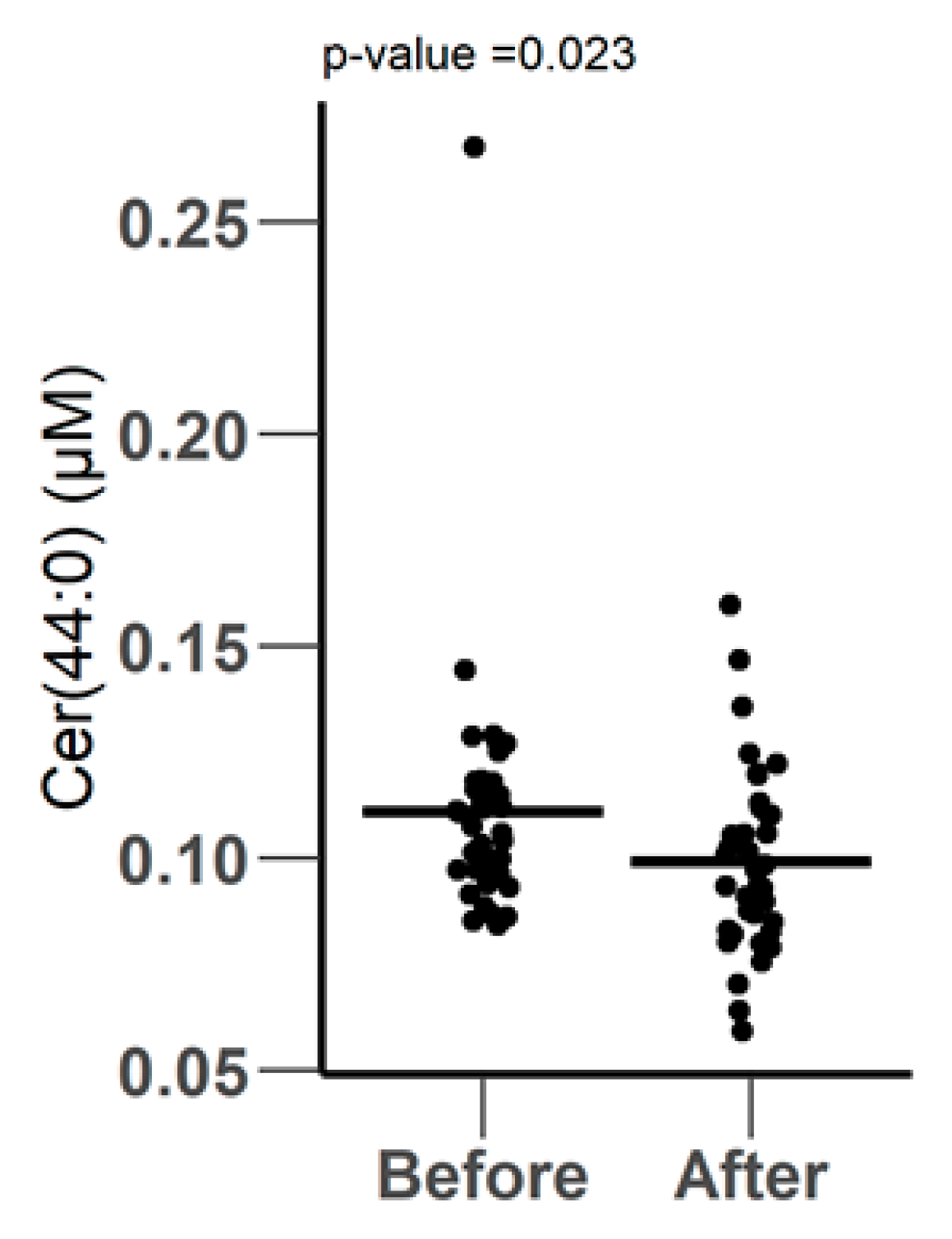Targeted Metabolomics Analysis on Obstructive Sleep Apnea Patients after Multilevel Sleep Surgery
Abstract
1. Introduction
2. Results
2.1. Study Population Characteristics
2.2. Polysomnographic Data
2.3. Metabolomics Analysis of People with OSA after MLS
2.4. Metabolomics Global Analysis
2.5. Differentially Expressed Triglyceride Metabolites
2.6. Differentially Expressed Phospholipid Metabolites
2.7. Differentially Expressed Sphingolipid Metabolites
2.8. Biomarker Evaluation
3. Discussion
4. Materials and Methods
4.1. Study Population and Ethical Statement
4.2. OSA Assessment and the Surgery Procedures
4.3. Blood Collection and Anthropometric and Biochemical Measurements
4.4. Metabolomics Analyses
4.5. Statistical Analysis
Supplementary Materials
Author Contributions
Funding
Acknowledgments
Conflicts of Interest
Abbreviations
| AI | Apnea Index |
| HI | Hypoapnea Index |
| AHI | Apnea/hypopnea index |
| BMI | Body mass index |
| CV | Coefficients of variation |
| HDL | High-density lipoprotein |
| LDL | Low-density lipoprotein |
| ELISA | Enzyme-linked immunosorbent assay |
| TC | Total cholesterol |
| FBG | Fasting blood glucose |
| HbA1C | Glycated haemoglobin |
| ANGPTL | Angiopoietin-like protein |
| SBP | Systolic blood pressure |
| DBP | Diastolic blood pressure |
| TG | Triglyceride |
| IH | Intermittent hypoxia |
| MLS | Multilevel Sleep Surgery |
| PSG | Polysomnography |
| CPAP | Continuous Positive Airway Pressure |
References
- Levy, P.; Kohler, M.; McNicholas, W.T.; Barbe, F.; McEvoy, R.D.; Somers, V.K.; Lavie, L.; Pepin, J.L. Obstructive sleep apnoea syndrome. Nat. Rev. Dis. Primers 2015, 1, 15015. [Google Scholar] [CrossRef]
- Basoglu, O.K.; Tasbakan, M.S. Elevated risk of sleepiness-related motor vehicle accidents in patients with obstructive sleep apnea syndrome: A case-control study. Traffic Inj. Prev. 2014, 15, 470–476. [Google Scholar] [CrossRef]
- Jurado-Gamez, B.; Guglielmi, O.; Gude, F.; Buela-Casal, G. Workplace accidents, absenteeism and productivity in patients with sleep apnea. Arch. Bronconeumol. 2015, 51, 213–218. [Google Scholar] [CrossRef]
- Saunders, K.H.; Igel, L.I.; Tchang, B.G. Surgical and Nonsurgical Weight Loss for Patients with Obstructive Sleep Apnea. Otolaryngol. Clin. N. Am. 2020, 53, 409–420. [Google Scholar] [CrossRef]
- Gottlieb, D.J.; Punjabi, N.M. Diagnosis and Management of Obstructive Sleep Apnea: A Review. JAMA 2020, 323, 1389–1400. [Google Scholar] [CrossRef] [PubMed]
- Cai, Y.; Goldberg, A.N.; Chang, J.L. The Nose and Nasal Breathing in Sleep Apnea. Otolaryngol. Clin. N. Am. 2020, 53, 385–395. [Google Scholar] [CrossRef]
- Kotecha, B.T.; Hall, A.C. Role of surgery in adult obstructive sleep apnoea. Sleep Med. Rev. 2014, 18, 405–413. [Google Scholar] [CrossRef] [PubMed]
- Verse, T. Update on surgery for obstructive sleep apnea syndrome. HNO 2008, 56, 1098–1104. [Google Scholar] [CrossRef]
- Gopalakrishnan, P.; Tak, T. Obstructive sleep apnea and cardiovascular disease. Cardiol. Rev. 2011, 19, 279–290. [Google Scholar] [CrossRef] [PubMed]
- Kendzerska, T.; Gershon, A.S.; Hawker, G.; Tomlinson, G.; Leung, R.S. Obstructive sleep apnea and incident diabetes. A historical cohort study. Am. J. Respir Crit Care Med. 2014, 190, 218–225. [Google Scholar] [CrossRef]
- Rasche, K.; Keller, T.; Tautz, B.; Hader, C.; Hergenc, G.; Antosiewicz, J.; Di Giulio, C.; Pokorski, M. Obstructive sleep apnea and type 2 diabetes. Eur. J. Med. Res. 2010, 15 (Suppl. 2), 152–156. [Google Scholar] [CrossRef][Green Version]
- Godoy, J.; Mellado, P.; Tapia, J.; Santin, J. Obstructive sleep apnea as an independent stroke risk factor: Possible mechanisms. Curr. Mol. Med. 2009, 9, 203–209. [Google Scholar] [CrossRef] [PubMed]
- Ryan, S. Adipose tissue inflammation by intermittent hypoxia: Mechanistic link between obstructive sleep apnoea and metabolic dysfunction. J. Physiol. 2017, 595, 2423–2430. [Google Scholar] [CrossRef] [PubMed]
- Passali, D.; Corallo, G.; Yaremchuk, S.; Longini, M.; Proietti, F.; Passali, G.C.; Bellussi, L. Oxidative stress in patients with obstructive sleep apnoea syndrome. Acta Otorhinolaryngol. Ital. 2015, 35, 420–425. [Google Scholar] [CrossRef] [PubMed]
- Toraldo, D.M.; De Nuccio, F.; De Benedetto, M.; Scoditti, E. Obstructive sleep apnoea syndrome: A new paradigm by chronic nocturnal intermittent hypoxia and sleep disruption. Acta Otorhinolaryngol. Ital. 2015, 35, 69–74. [Google Scholar] [PubMed]
- Sanchez-de-la-Torre, M.; Campos-Rodriguez, F.; Barbe, F. Obstructive sleep apnoea and cardiovascular disease. Lancet Respir. Med. 2013, 1, 61–72. [Google Scholar] [CrossRef]
- Lam, J.C.; Mak, J.C.; Ip, M.S. Obesity, obstructive sleep apnoea and metabolic syndrome. Respirology 2012, 17, 223–236. [Google Scholar] [CrossRef]
- Kimoff, R.J.; Hamid, Q.; Divangahi, M.; Hussain, S.; Bao, W.; Naor, N.; Payne, R.J.; Ariyarajah, A.; Mulrain, K.; Petrof, B.J. Increased upper airway cytokines and oxidative stress in severe obstructive sleep apnoea. Eur. Respir. J. 2011, 38, 89–97. [Google Scholar] [CrossRef]
- Bradley, T.D.; Floras, J.S. Obstructive sleep apnoea and its cardiovascular consequences. Lancet 2009, 373, 82–93. [Google Scholar] [CrossRef]
- Lin, M.T.; Lin, H.H.; Lee, P.L.; Weng, P.H.; Lee, C.C.; Lai, T.C.; Liu, W.; Chen, C.L. Beneficial effect of continuous positive airway pressure on lipid profiles in obstructive sleep apnea: A meta-analysis. Sleep Breath 2015, 19, 809–817. [Google Scholar] [CrossRef]
- Yao, Q.; Shin, M.K.; Jun, J.C.; Hernandez, K.L.; Aggarwal, N.R.; Mock, J.R.; Gay, J.; Drager, L.F.; Polotsky, V.Y. Effect of chronic intermittent hypoxia on triglyceride uptake in different tissues. J. Lipid Res. 2013, 54, 1058–1065. [Google Scholar] [CrossRef] [PubMed]
- Jun, J.C.; Shin, M.K.; Yao, Q.; Bevans-Fonti, S.; Poole, J.; Drager, L.F.; Polotsky, V.Y. Acute hypoxia induces hypertriglyceridemia by decreasing plasma triglyceride clearance in mice. Am. J. Physiol. Endocrinol. Metab. 2012, 303, E377–E388. [Google Scholar] [CrossRef] [PubMed]
- Drager, L.F.; Li, J.; Shin, M.K.; Reinke, C.; Aggarwal, N.R.; Jun, J.C.; Bevans-Fonti, S.; Sztalryd, C.; O’Byrne, S.M.; Kroupa, O.; et al. Intermittent hypoxia inhibits clearance of triglyceride-rich lipoproteins and inactivates adipose lipoprotein lipase in a mouse model of sleep apnoea. Eur. Heart J. 2012, 33, 783–790. [Google Scholar] [CrossRef] [PubMed]
- Al-Terki, A.; Abu-Farha, M.; AlKhairi, I.; Cherian, P.T.; Sriraman, D.; Shyamsundar, A.; Ali, S.; Almulla, F.; Tuomilehto, J.; Abubaker, J.A. Increased Level of Angiopoietin Like Proteins 4 and 8 in People with Sleep Apnea. Front. Endocrinol. (Lausanne) 2018, 9, 651. [Google Scholar] [CrossRef]
- Haller, J.F.; Mintah, I.J.; Shihanian, L.M.; Stevis, P.; Buckler, D.; Alexa-Braun, C.A.; Kleiner, S.; Banfi, S.; Cohen, J.C.; Hobbs, H.H.; et al. ANGPTL8 requires ANGPTL3 to inhibit lipoprotein lipase and plasma triglyceride clearance. J. Lipid Res. 2017, 58, 1166–1173. [Google Scholar] [CrossRef]
- Reimund, M.; Kovrov, O.; Olivecrona, G.; Lookene, A. Lipoprotein lipase activity and interactions studied in human plasma by isothermal titration calorimetry. J. Lipid Res. 2017, 58, 279–288. [Google Scholar] [CrossRef]
- Zhang, R. The ANGPTL3-4-8 model, a molecular mechanism for triglyceride trafficking. Open Biol. 2016, 6, 150272. [Google Scholar] [CrossRef]
- Sengupta, A.; Weljie, A.M. Metabolism of sleep and aging: Bridging the gap using metabolomics. Nutr. Healthy Aging 2019, 5, 167–184. [Google Scholar] [CrossRef]
- Ferrarini, A.; Ruperez, F.J.; Erazo, M.; Martinez, M.P.; Villar-Alvarez, F.; Peces-Barba, G.; Gonzalez-Mangado, N.; Troncoso, M.F.; Ruiz-Cabello, J.; Barbas, C. Fingerprinting-based metabolomic approach with LC-MS to sleep apnea and hypopnea syndrome: A pilot study. Electrophoresis 2013, 34, 2873–2881. [Google Scholar] [CrossRef]
- Jacob, M.; Lopata, A.L.; Dasouki, M.; Abdel Rahman, A.M. Metabolomics toward personalized medicine. Mass Spectrom Rev. 2019, 38, 221–238. [Google Scholar] [CrossRef]
- Diallo, I.; Pak, V.M. Metabolomics, sleepiness, and sleep duration in sleep apnea. Sleep Breath 2020, 1–6. [Google Scholar] [CrossRef]
- Xu, H.; Li, X.; Zheng, X.; Xia, Y.; Fu, Y.; Li, X.; Qian, Y.; Zou, J.; Zhao, A.; Guan, J.; et al. Pediatric Obstructive Sleep Apnea is Associated With Changes in the Oral Microbiome and Urinary Metabolomics Profile: A Pilot Study. J. Clin. Sleep Med. 2018, 14, 1559–1567. [Google Scholar] [CrossRef] [PubMed]
- Xu, H.; Zheng, X.; Qian, Y.; Guan, J.; Yi, H.; Zou, J.; Wang, Y.; Meng, L.; Zhao, A.; Yin, S.; et al. Metabolomics Profiling for Obstructive Sleep Apnea and Simple Snorers. Sci. Rep. 2016, 6, 30958. [Google Scholar] [CrossRef] [PubMed]
- Jacob, M.; Bin Khalaf, D.; Alhissi, S.; Arnout, R.; Alsaud, B.; Al-Mousa, H.; Lopata, A.L.; Alazami, A.M.; Dasouki, M.; Abdel Rahman, A.M. Quantitative profiling of cytokines and chemokines in DOCK8-deficient and atopic dermatitis patients. Allergy 2019, 74, 370–379. [Google Scholar] [CrossRef] [PubMed]
- Dahabiyeh, L.A.; Malkawi, A.K.; Wang, X.; Colak, D.; Mujamammi, A.H.; Sabi, E.M.; Li, L.; Dasouki, M.; Abdel Rahman, A.M. Dexamethasone-Induced Perturbations in Tissue Metabolomics Revealed by Chemical Isotope Labeling LC-MS analysis. Metabolites 2020, 10, 42. [Google Scholar] [CrossRef] [PubMed]
- Ota, H.; Fujita, Y.; Yamauchi, M.; Muro, S.; Kimura, H.; Takasawa, S. Relationship Between Intermittent Hypoxia and Type 2 Diabetes in Sleep Apnea Syndrome. Int. J. Mol. Sci. 2019, 20, 4756. [Google Scholar] [CrossRef]
- Subramanian, A.; Adderley, N.J.; Tracy, A.; Taverner, T.; Hanif, W.; Toulis, K.A.; Thomas, G.N.; Tahrani, A.A.; Nirantharakumar, K. Risk of Incident Obstructive Sleep Apnea Among Patients with Type 2 Diabetes. Diabetes Care 2019, 42, 954–963. [Google Scholar] [CrossRef]
- Tahrani, A.A. Obstructive sleep apnoea in diabetes: Does it matter? Diab. Vasc. Dis. Res. 2017, 14, 454–462. [Google Scholar] [CrossRef]
- Tahrani, A.A.; Ali, A.; Stevens, M.J. Obstructive sleep apnoea and diabetes: An update. Curr. Opin. Pulm. Med. 2013, 19, 631–638. [Google Scholar] [CrossRef]
- Humbert, F.; Salvat, G.; Colin, P.; Lahellec, C.; Bennejean, G. Rapid identification of Salmonella from poultry meat products by using ‘Mucap Test’. Int. J. Food Microbiol. 1989, 8, 79–83. [Google Scholar] [CrossRef]
- Leong, W.B.; Jadhakhan, F.; Taheri, S.; Chen, Y.F.; Adab, P.; Thomas, G.N. Effect of obstructive sleep apnoea on diabetic retinopathy and maculopathy: A systematic review and meta-analysis. Diabet Med. 2016, 33, 158–168. [Google Scholar] [CrossRef] [PubMed]
- Alhyas, L.; McKay, A.; Majeed, A. Prevalence of type 2 diabetes in the States of the co-operation council for the Arab States of the Gulf: A systematic review. PLoS ONE 2012, 7, e40948. [Google Scholar] [CrossRef] [PubMed]
- Al Rashdan, I.; Al Nesef, Y. Prevalence of overweight, obesity, and metabolic syndrome among adult Kuwaitis: Results from community-based national survey. Angiology 2010, 61, 42–48. [Google Scholar] [CrossRef] [PubMed]
- Reckley, L.K.; Fernandez-Salvador, C.; Camacho, M. The effect of tonsillectomy on obstructive sleep apnea: An overview of systematic reviews. Nat. Sci. Sleep 2018, 10, 105–110. [Google Scholar] [CrossRef] [PubMed]
- Barros, D.; Garcia-Rio, F. Obstructive sleep apnea and dyslipidemia: From animal models to clinical evidence. Sleep 2019, 42, zsy236. [Google Scholar] [CrossRef]
- Castaneda, A.; Jauregui-Maldonado, E.; Ratnani, I.; Varon, J.; Surani, S. Correlation between metabolic syndrome and sleep apnea. World J. Diabetes 2018, 9, 66–71. [Google Scholar] [CrossRef]
- Hu, K.; Babapoor-Farrokhran, S.; Rodrigues, M.; Deshpande, M.; Puchner, B.; Kashiwabuchi, F.; Hassan, S.J.; Asnaghi, L.; Handa, J.T.; Merbs, S.; et al. Hypoxia-inducible factor 1 upregulation of both VEGF and ANGPTL4 is required to promote the angiogenic phenotype in uveal melanoma. Oncotarget 2016, 7, 7816–7828. [Google Scholar] [CrossRef]
- Abu-Farha, M.; Abubaker, J.; Tuomilehto, J. ANGPTL8 (betatrophin) role in diabetes and metabolic diseases. Diabetes/Metab. Res. Rev. 2017, 33, e2919. [Google Scholar] [CrossRef]
- Nielsen, S.; Karpe, F. Determinants of VLDL-triglycerides production. Curr. Opin. Lipidol. 2012, 23, 321–326. [Google Scholar] [CrossRef]
- Abu-Farha, M.; Abubaker, J.; Al-Khairi, I.; Cherian, P.; Noronha, F.; Hu, F.B.; Behbehani, K.; Elkum, N. Higher plasma betatrophin/ANGPTL8 level in Type 2 Diabetes subjects does not correlate with blood glucose or insulin resistance. Sci. Rep. 2015, 5, 10949. [Google Scholar] [CrossRef]
- Inoue, T.; Kohro, T.; Tanaka, T.; Kanki, Y.; Li, G.; Poh, H.M.; Mimura, I.; Kobayashi, M.; Taguchi, A.; Maejima, T.; et al. Cross-enhancement of ANGPTL4 transcription by HIF1 alpha and PPAR beta/delta is the result of the conformational proximity of two response elements. Genome Biol. 2014, 15, R63. [Google Scholar] [CrossRef] [PubMed]
- Zhang, H.; Wong, C.C.; Wei, H.; Gilkes, D.M.; Korangath, P.; Chaturvedi, P.; Schito, L.; Chen, J.; Krishnamachary, B.; Winnard, P.T., Jr.; et al. HIF-1-dependent expression of angiopoietin-like 4 and L1CAM mediates vascular metastasis of hypoxic breast cancer cells to the lungs. Oncogene 2012, 31, 1757–1770. [Google Scholar] [CrossRef] [PubMed]
- Knowles, H.J.; Cleton-Jansen, A.M.; Korsching, E.; Athanasou, N.A. Hypoxia-inducible factor regulates osteoclast-mediated bone resorption: Role of angiopoietin-like 4. FASEB J. 2010, 24, 4648–4659. [Google Scholar] [CrossRef] [PubMed]
- Drager, L.F.; Yao, Q.; Hernandez, K.L.; Shin, M.K.; Bevans-Fonti, S.; Gay, J.; Sussan, T.E.; Jun, J.C.; Myers, A.C.; Olivecrona, G.; et al. Chronic intermittent hypoxia induces atherosclerosis via activation of adipose angiopoietin-like 4. Am. J. Respir Crit. Care Med. 2013, 188, 240–248. [Google Scholar] [CrossRef] [PubMed]
- Drager, L.F.; Tavoni, T.M.; Silva, V.M.; Santos, R.D.; Pedrosa, R.P.; Bortolotto, L.A.; Vinagre, C.G.; Polotsky, V.Y.; Lorenzi-Filho, G.; Maranhao, R.C. Obstructive sleep apnea and effects of continuous positive airway pressure on triglyceride-rich lipoprotein metabolism. J. Lipid Res. 2018, 59, 1027–1033. [Google Scholar] [CrossRef] [PubMed]
- Gruhle, K.; Muller, S.; Meister, A.; Drescher, S. Synthesis and aggregation behaviour of single-chain, 1,32-alkyl branched bis(phosphocholines): Effect of lateral chain length. Org. Biomol. Chem 2018, 16, 2711–2724. [Google Scholar] [CrossRef] [PubMed]
- Drescher, S.; Meister, A.; Blume, A.; Karlsson, G.; Almgren, M.; Dobner, B. General synthesis and aggregation behaviour of a series of single-chain 1,omega-bis(phosphocholines). Chemistry 2007, 13, 5300–5307. [Google Scholar] [CrossRef] [PubMed]
- De Haas, G.H.; van Oort, M.G.; Dijkman, R.; Verger, R. Phospholipase A2 inhibitors: Monoacyl, monoacylamino-glycero-phosphocholines. Biochem. Soc. Trans. 1989, 17, 274–276. [Google Scholar] [CrossRef]
- Lebkuchen, A.; Carvalho, V.M.; Venturini, G.; Salgueiro, J.S.; Freitas, L.S.; Dellavance, A.; Martins, F.C.; Lorenzi-Filho, G.; Cardozo, K.H.M.; Drager, L.F. Metabolomic and lipidomic profile in men with obstructive sleep apnoea: Implications for diagnosis and biomarkers of cardiovascular risk. Sci. Rep. 2018, 8, 11270. [Google Scholar] [CrossRef]
- Kheirandish-Gozal, L.; Philby, M.F.; Qiao, Z.; Khalyfa, A.; Gozal, D. Endothelial Dysfunction in Children With Obstructive Sleep Apnea Is Associated With Elevated Lipoprotein-Associated Phospholipase A2 Plasma Activity Levels. J. Am. Heart Assoc. 2017, 6. [Google Scholar] [CrossRef]
- Ward-Caviness, C.K.; Xu, T.; Aspelund, T.; Thorand, B.; Montrone, C.; Meisinger, C.; Dunger-Kaltenbach, I.; Zierer, A.; Yu, Z.; Helgadottir, I.R.; et al. Improvement of myocardial infarction risk prediction via inflammation-associated metabolite biomarkers. Heart 2017, 103, 1278–1285. [Google Scholar] [CrossRef] [PubMed]
- Abubaker, J.; Tiss, A.; Abu-Farha, M.; Al-Ghimlas, F.; Al-Khairi, I.; Baturcam, E.; Cherian, P.; Elkum, N.; Hammad, M.; John, J.; et al. DNAJB3/HSP-40 cochaperone is downregulated in obese humans and is restored by physical exercise. PLoS ONE 2013, 8, e69217. [Google Scholar] [CrossRef] [PubMed]
- Abu-Farha, M.; Cherian, P.; Al-Khairi, I.; Tiss, A.; Khadir, A.; Kavalakatt, S.; Warsame, S.; Dehbi, M.; Behbehani, K.; Abubaker, J. DNAJB3/HSP-40 cochaperone improves insulin signaling and enhances glucose uptake in vitro through JNK repression. Sci. Rep. 2015, 5, 14448. [Google Scholar] [CrossRef] [PubMed]






| Before Surgery (n = 39) | After Surgery (n = 39) | p-Value | |
|---|---|---|---|
| AGE Year | |||
| Mean (SD) | 40.0 (10.5) | NA | |
| Median [Min, Max] | 40.0 [24.0, 65.0] | ||
| BMI Kg/m2 | |||
| Mean (SD) | 30.2 (4.41) | 29.6 (4.61) | 0.121 |
| Median [Min, Max] | 30.0 [20.2, 38.3] | 30.0 [19.0, 38.5] | |
| SBP | |||
| Mean (SD) | 125 (12.7) | 124 (13.0) | 0.686 |
| Median [Min, Max] | 125 [97.0, 149] | 124 [99.0, 151] | |
| DBP | |||
| Mean (SD) | 73.1 (10.2) | 76.7 (9.79) | 0.248 |
| Median [Min, Max] | 72.0 [55.0, 92.0] | 77.5 [57.0, 94.0] | |
| AHI Events/Hour | |||
| Mean (SD) | 22.0 (18.5) | 8.97 (9.57) | <0.001 |
| Median [Min, Max] | 17.0 [5.70, 93.5] | 6.10 [0, 42.8] | |
| AI Events/Hour | |||
| Mean (SD) | 2.30 (2.62) | 3.64 (6.86) | 0.862 |
| Median [Min, Max] | 0.900 [0.100, 7.10] | 0.700 [0.100, 15.9] | |
| HI Events/Hour | |||
| Mean (SD) | 15.8 (10.1) | 6.30 (4.93) | 0.193 |
| Median [Min, Max] | 13.5 [4.50, 50.0] | 5.80 [0, 15.4] | |
| ESS | |||
| Mean (SD) | 12.8 (6.23) | 2.95 (2.40) | <0.001 |
| Median [Min, Max] | 13.5 [2.00, 24.0] | 3.00 [0, 8.00] | |
| TOTAL CHOL mmol/L | |||
| Mean (SD) | 4.96 (1.30) | 4.96 (1.30) | 0.935 |
| Median [Min, Max] | 5.15 [2.90, 9.20] | 4.80 [3.30, 9.90] | |
| HDL mmol/L | |||
| Mean (SD) | 1.10 (0.238) | 1.10 (0.260) | 0.848 |
| Median [Min, Max] | 1.05 [0.770, 1.64] | 1.11 [0.320, 1.54] | |
| LDL mmol/L | |||
| Mean (SD) | 3.19 (1.21) | 3.24 (1.37) | 0.976 |
| Median [Min, Max] | 3.30 [1.30, 7.50] | 3.10 [1.40, 8.70] | |
| TG mmol/L | |||
| Mean (SD) | 1.47 (0.945) | 1.36 (0.411) | 0.99 |
| Median [Min, Max] | 1.26 [0.470, 5.75] | 1.25 [0.650, 2.06] | |
| FG mmol/L | |||
| Mean (SD) | 5.77 (1.23) | 5.77 (1.08) | 0.794 |
| Median [Min, Max] | 5.50 [4.70, 11.4] | 5.55 [4.70, 9.70] | |
| HbA1c % | |||
| Mean (SD) | 5.69 (0.698) | 5.59 (0.552) | 0.76 |
| Median [Min, Max] | 5.60 [4.60, 8.40] | 5.50 [4.60, 7.70] |
© 2020 by the authors. Licensee MDPI, Basel, Switzerland. This article is an open access article distributed under the terms and conditions of the Creative Commons Attribution (CC BY) license (http://creativecommons.org/licenses/by/4.0/).
Share and Cite
Alterki, A.; Joseph, S.; Thanaraj, T.A.; Al-Khairi, I.; Cherian, P.; Channanath, A.; Sriraman, D.; Ebrahim, M.A.K.; Ibrahim, A.; Tiss, A.; et al. Targeted Metabolomics Analysis on Obstructive Sleep Apnea Patients after Multilevel Sleep Surgery. Metabolites 2020, 10, 358. https://doi.org/10.3390/metabo10090358
Alterki A, Joseph S, Thanaraj TA, Al-Khairi I, Cherian P, Channanath A, Sriraman D, Ebrahim MAK, Ibrahim A, Tiss A, et al. Targeted Metabolomics Analysis on Obstructive Sleep Apnea Patients after Multilevel Sleep Surgery. Metabolites. 2020; 10(9):358. https://doi.org/10.3390/metabo10090358
Chicago/Turabian StyleAlterki, Abdulmohsen, Shibu Joseph, Thangavel Alphonse Thanaraj, Irina Al-Khairi, Preethi Cherian, Arshad Channanath, Devarajan Sriraman, Mahmoud A. K. Ebrahim, Alaaeldin Ibrahim, Ali Tiss, and et al. 2020. "Targeted Metabolomics Analysis on Obstructive Sleep Apnea Patients after Multilevel Sleep Surgery" Metabolites 10, no. 9: 358. https://doi.org/10.3390/metabo10090358
APA StyleAlterki, A., Joseph, S., Thanaraj, T. A., Al-Khairi, I., Cherian, P., Channanath, A., Sriraman, D., Ebrahim, M. A. K., Ibrahim, A., Tiss, A., Al-Mulla, F., Rahman, A. M. A., Abubaker, J., & Abu-Farha, M. (2020). Targeted Metabolomics Analysis on Obstructive Sleep Apnea Patients after Multilevel Sleep Surgery. Metabolites, 10(9), 358. https://doi.org/10.3390/metabo10090358







